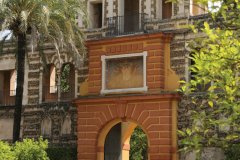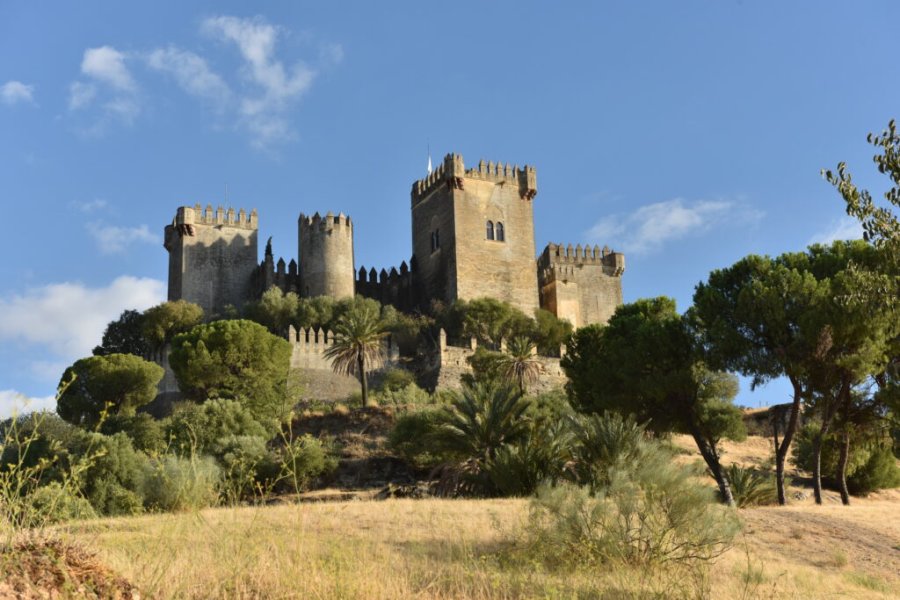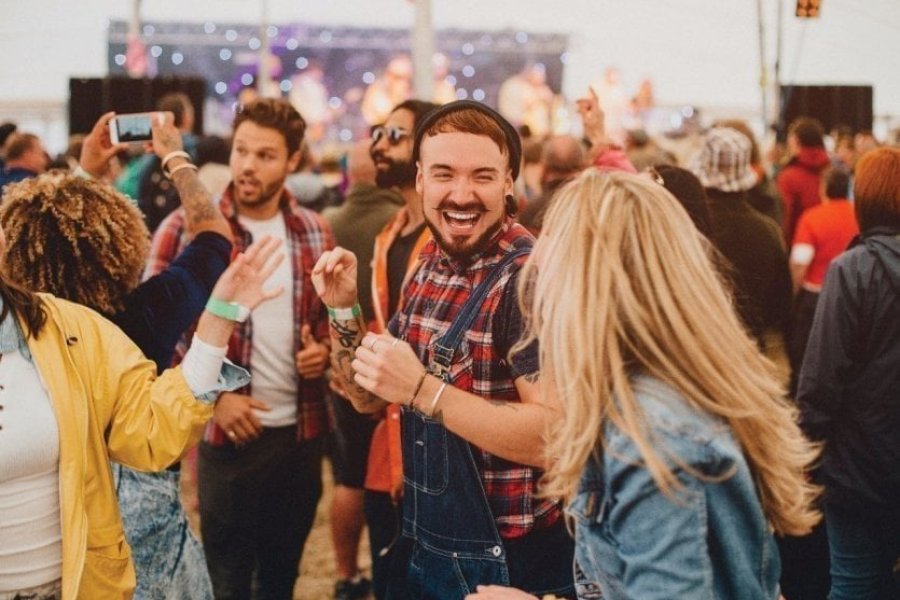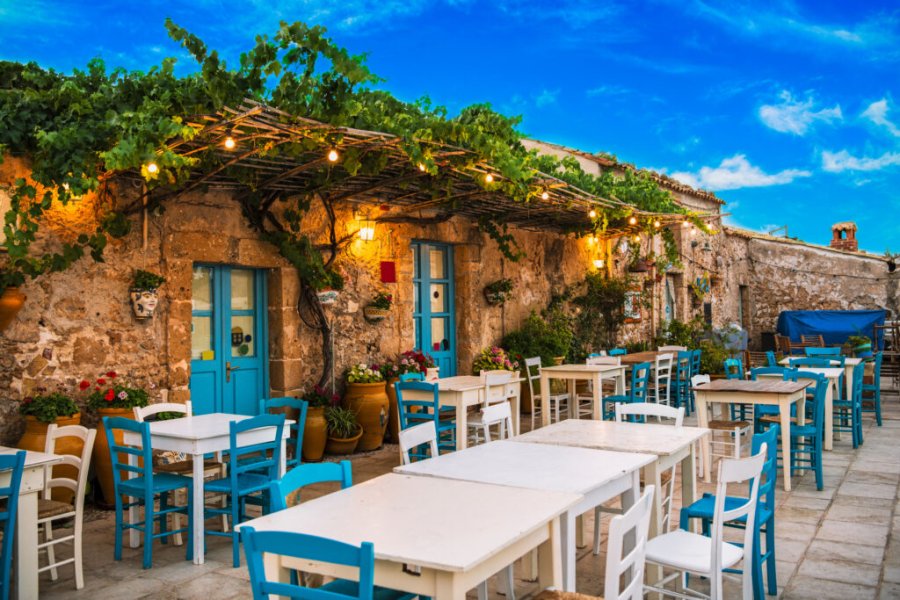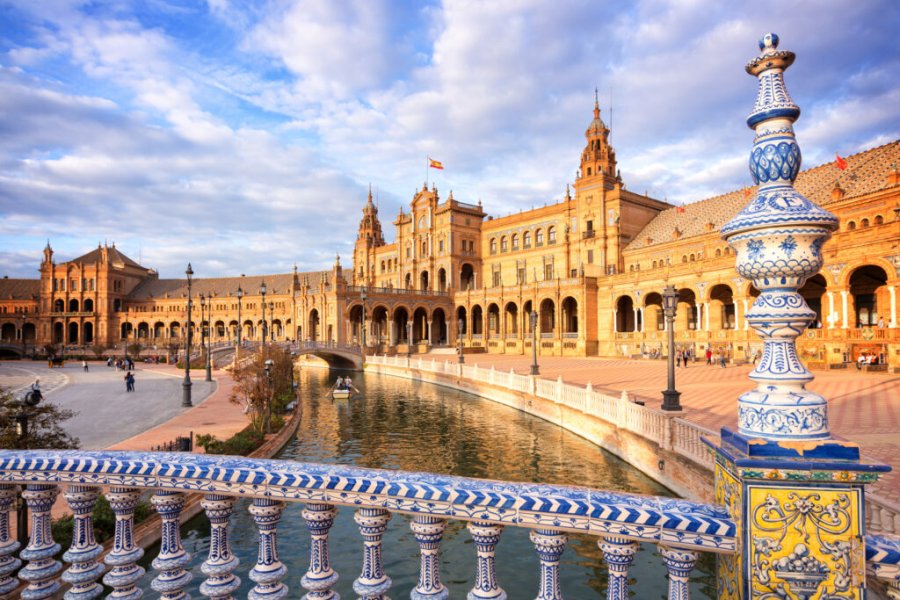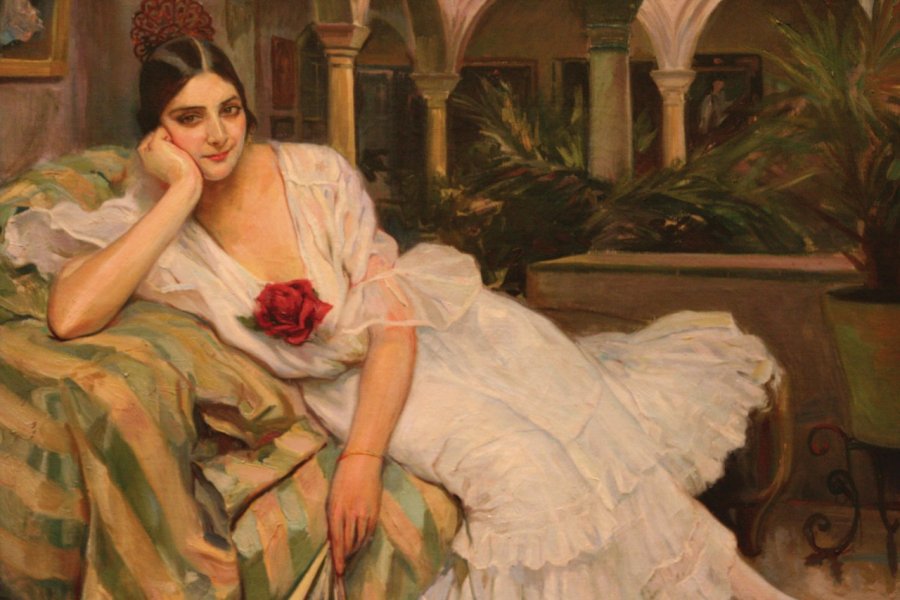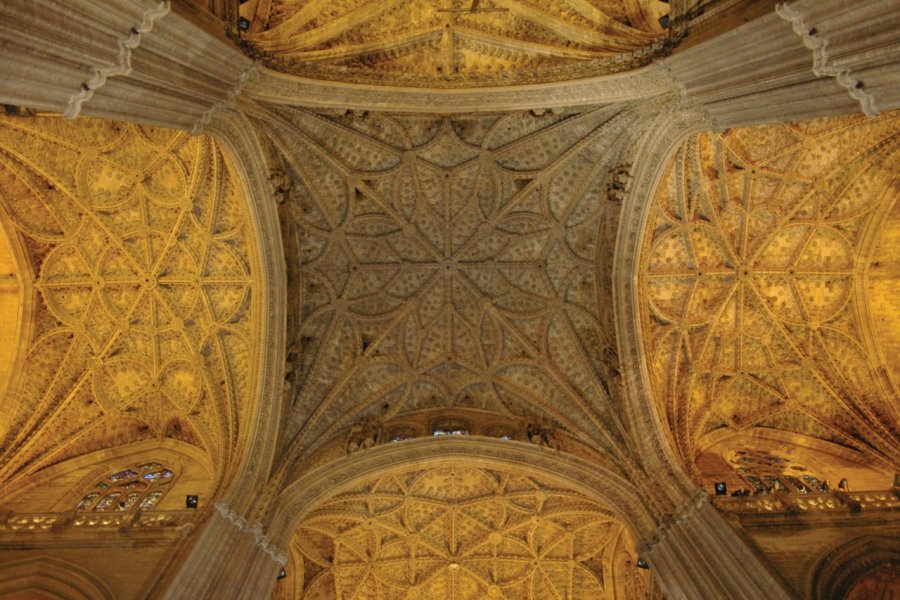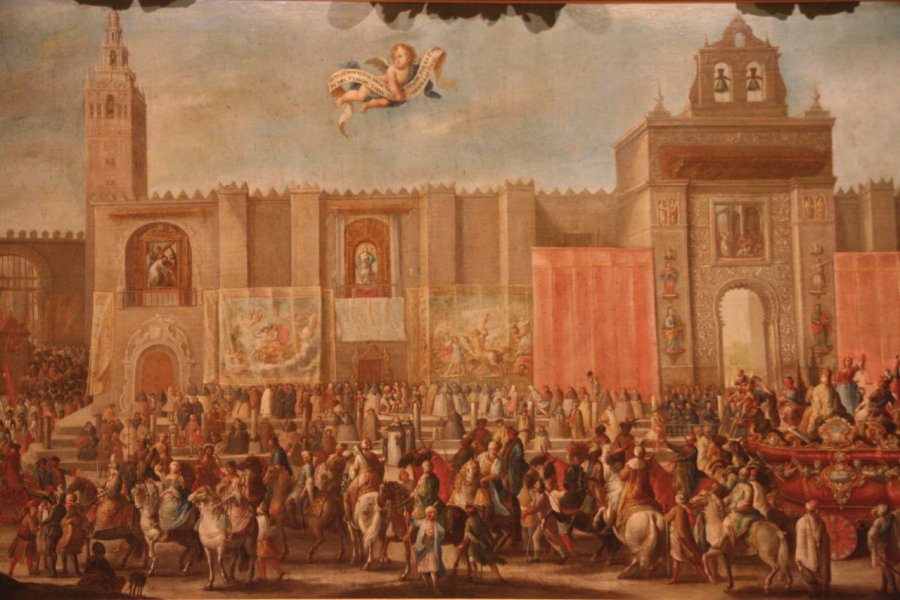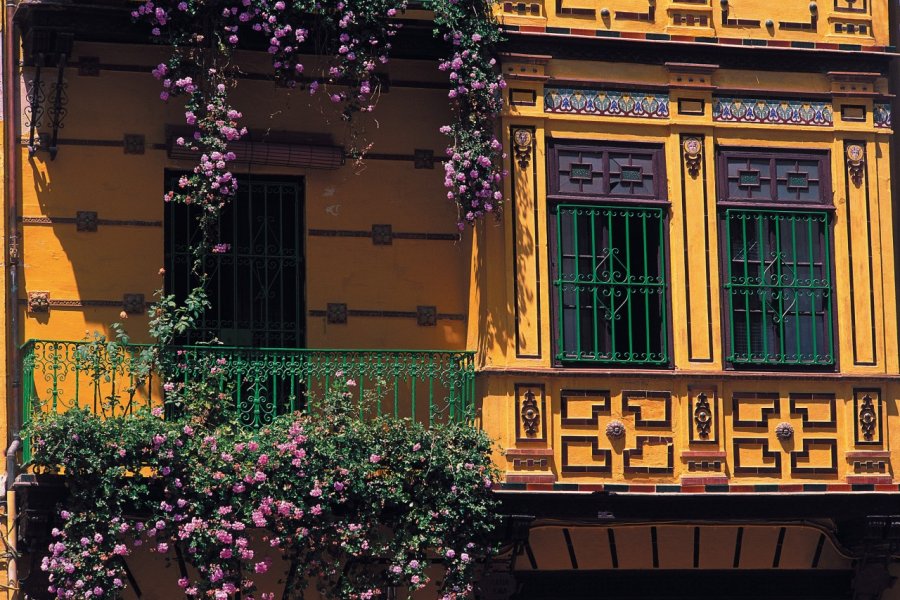Travel guide Sevilla
A city of celebration and culture where the sun shines nearly 300 days a year, Seville is the perfect destination for a weekend or a week in Spain. Located along the Guadalquivir River, which connects it to the Atlantic Ocean 70 kilometers away, the capital ofAndalusia offers a marvelous mix of Gothic architecture, the result of the successive passage of Greeks, Phoenicians, Arabs and Christians. Symbols of this beautiful diversity are its immense cathedral, which has transformed into a bell tower, the Giralda, the minaret of the old mosque on which it was built, and of course the palace and gardens of the Real Alcazar, built by the Arabs and later redeveloped by the Catholic kings. In addition to these two monuments, Seville has a lot of traditional and modern neighborhoods, where it is good to get lost, between monumental squares such as the Plaza de España or squares decorated with fountains and orange trees, colored doors and windows, paved streets and green patios covered with tiles. As soon as the weather gets milder and night falls, Seville puts on its festive clothes and invites you to a flamenco tune in one of the tapas bars that brighten up its streets to meet a population that sometimes seems to live outside. The historic center is full of treasures. A visit to the Andalusian capital can extend to the outskirts. It is a city that will please sports lovers, especially with two famous clubs that play in the first division: Sevilla FC and Betis Sevilla. Seville is without a doubt one of the great Spanish cities like Madrid or Barcelona. It is a place you must visit in search of the mysteries that feed the folklore of the region! Don't wait any longer to go on a trip.
What to see, what to do Sevilla?
-
Book an activity
-
Customized travel
- Addresses to visit Sevilla
When to go Sevilla ?
The best time to discover Seville is in spring (March to June). However, you should know that in April, tourist numbers are at their peak: it is during this time that Holy Week and the Feria are celebrated; accommodation prices sometimes increase by more than 50%! Petit futé advises you to visit Seville in September and October when the temperatures are still very pleasant and the Bienal del Flamenco is held (and the bullfighting season which only ends on October 12). In summer (July-August), it is stifling hot, the thermometer explodes and activity ceases (many establishments are closed). Autumn and winter are mild and quiet seasons. The Christmas season attracts a large number of tourists. You will find more practical information in your travel guide.
Weather at the moment
Suggested addresses Sevilla
Travel Sevilla
-
Find a hotel
-
Car Rental
-
International e-SIM package
-
Find a local agency
Find unique Stay Offers with our Partners
How to go Sevilla
How to go alone
There are many direct flights to Seville. The price of a flight to Seville can vary from one to two, depending on the period and the airline. To get a good price, it is necessary to book in advance. Seville is a safe city, there is not much to fear. The only real danger you may face is theft. As is the case in most tourist cities, pickpockets and pickpockets operate in Seville.
How to go on a tour
Seville is often part of a larger tour of Andalusia that includes other beautiful cities in the region such as Cordoba, Cadiz and Granada, as well as the white villages of the Sierra Nevada. Seville is often the city from which you will radiate with a return to your hotel most evenings. For those who fear the language barrier, it is possible to find a French-speaking interpreter guide. Moreover, they know the most important tourist sites by heart.
How to get around
There are of course horse-drawn carriage rides but you won't go far. If you stick to the city center, you won't really need public transportation except for the streetcar that crosses the historic districts because the area is not very large. To go to the outskirts, buses and the new metro are available. Tourist buses are also a good option for guided tours in Seville.
Featured articles Sevilla
Discover Sevilla
To discover Seville is first and foremost to retrace the 2,000 years of its history, which helped make it a leading cultural center during the Alhomade period, then a crucial point in the Reconquest, and finally the hub of trade to the New World. When it was both port and gateway to the Indies. All of which have left their mark on the city's superb monuments, such as the Reales Alcazares, the Cathedral and the General Archives of the Indies. In terms of artistic heritage, Seville's Semana Santa is one of its most moving facets, as is flamenco, now a World Heritage Site since 2010. It's in Seville that flamenco is at its best, whether in tablaos, bars or peñas that keep the flame alive. But its essence also lies in the art of tapeo , which has spread from here to virtually the whole of Spain.
Pictures and images Sevilla
The 12 keywords Sevilla
1. Alcázar
The construction of this fortified palace began under the impulse of the Almohads, then it was Peter the Cruel who, inspired by the Alhambra of Granada, asked architects and Mudejar workers to complete the construction of theReales Alcázares. Emblem of the city, the RealesAlcázares is now a Unesco World Heritage Site.
2. Azulejos

Its name comes from the Arabic azulaj meaning "small stone" because it was the Moors who introduced this technique of glazing the material, starting in the 11th century. In Seville, these glazed ceramic tiles adorn restaurants, streets, hotels, patios, public gardens ... Especially in the Triana district.
3. Carriage

They are waiting for you at the foot of the Giralda. If they are not used by the inhabitants to move around on a daily basis, they will be a pleasant means of transport to criss-cross the city, at a slow pace. The ride lasts a little less than an hour and will lead you to the discovery of sites not to be missed such as the Maria Luisa park or the Plaza de España
4. Carmen
It is in Seville, in the XIXth century, that Carmen, which inspired Georges Bizet, knew its tragic destiny. One of the most performed French operas in the world. It tells the story of an Andalusian gypsy, as whimsical as she is passionate, who lives without restraint and takes with her a brigadier, whom she will abandon for a bullfighter.
5. Casa de contratación
The Real Casa de Contratación de Indias was a Spanish royal colonial administration, created in Seville on January 20, 1503, during the Spanish colonization of America. It controlled all trade in the Spanish Indies. Replaced by the Archivos de las Indias, the Archives of the Indies, the building is also a Unesco heritage site.
6. Christopher Columbus
It was in Seville that he is said to have met the prior of the La Rábida monastery, who introduced him to Isabella of Castile, enabling him to obtain funding for his first voyage, after years of discussions. The body of the famous navigator now rests in Seville Cathedral, having previously been in the La Cartuja monastery.
7. Duende (el)
It's an elf, a will-o'-the-wisp... But it's also a kind of state of grace for the sender (singer, dancer, musician...) and something akin to trance for the receiver (audience). This word expresses the magic of flamenco, the artistic catharsis of the Andalusians. It can't be explained any more than that; it has to be lived, felt.
8. Fan
It is the indispensable accessory of the Sevillanas of all ages. Only they know the art of handling it with dexterity. In Seville, it is everywhere as soon as spring appears and it is not a luxury when temperatures exceed 30°C. There are all kinds, all colors, wood, ivory, plastic and at any price.
9. Flamenco
To honor this symbol of Sevillian folklore, every two years the city organizes an internationally renowned event: the Flamenco Biennial; an opportunity to discover this powerful expression of the Andalusian soul. For more than a month, the best artists come together in Seville to give the public unforgettable moments.
10. Giralda

Symbol of Seville, the old minaret of the Great Mosque of Almohad dating from the twelfth century became the bell tower of the cathedral of Seville, at the time of the reconquest. Rising to more than 98 m, it has no less than 25 bells. Its giraldillo, a small weathervane, weighs about 1,300 kg, but being hollow, it twirls with every gust of wind.
11. Guadalquivir
Crossing the Andalusian capital from north to south, it is to Seville what the Danube is to Budapest. Powerful and 579 km long, it gives the city its quiet strength. You can stroll along its banks or paddle its course in a boat or canoe. Its vast plain, the largest in Spain, has been responsible for all the agricultural development in the area.
12. Tapas

Varied and diverse, tapas are a miniature representation of regional gastronomic specialties. In Seville, people gather in bars or restaurants to enjoy, often standing around a high table or a barrel, some typical tapas: serrano ham, salmorejo, gazpacho, queso viejo (old cheese).
You are from here, if...
Your breakfast consists of tostadas, slices of toasted bread spread with tomato purée and a drizzle of oil; zumo de naranja, squeezed orange juice, and cafe con leche.
You take a siesta as soon as the heat arrives, and head for the beaches of the Cadiz and Huelva coasts at weekends.
You're a soccer fan, and you want to know which club the other prefers. Is it FC Sevilla or Betis? You prefer Betis.
You shun the big evening meal, preferring the tapeo. If possible, small fish or seafood dishes, accompanied by glasses of white wine.
You like to take your time and aren't fussy about schedules.
You practice theabrazo. You don't shake hands, it's too distant.
You wouldn't miss Semana Santa for the world, and you already know which route you'll take.
You drink your coffee on the rocks(cafe con hielo) in summer, as it's a good way to beat the heat.

